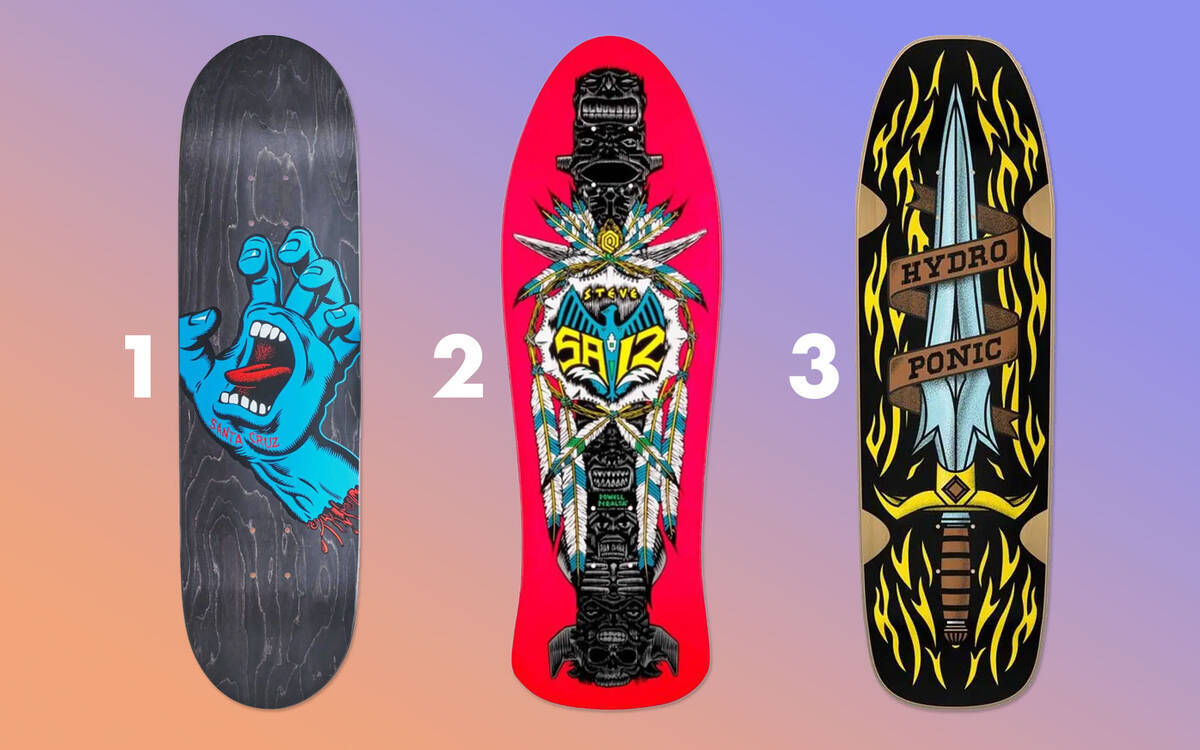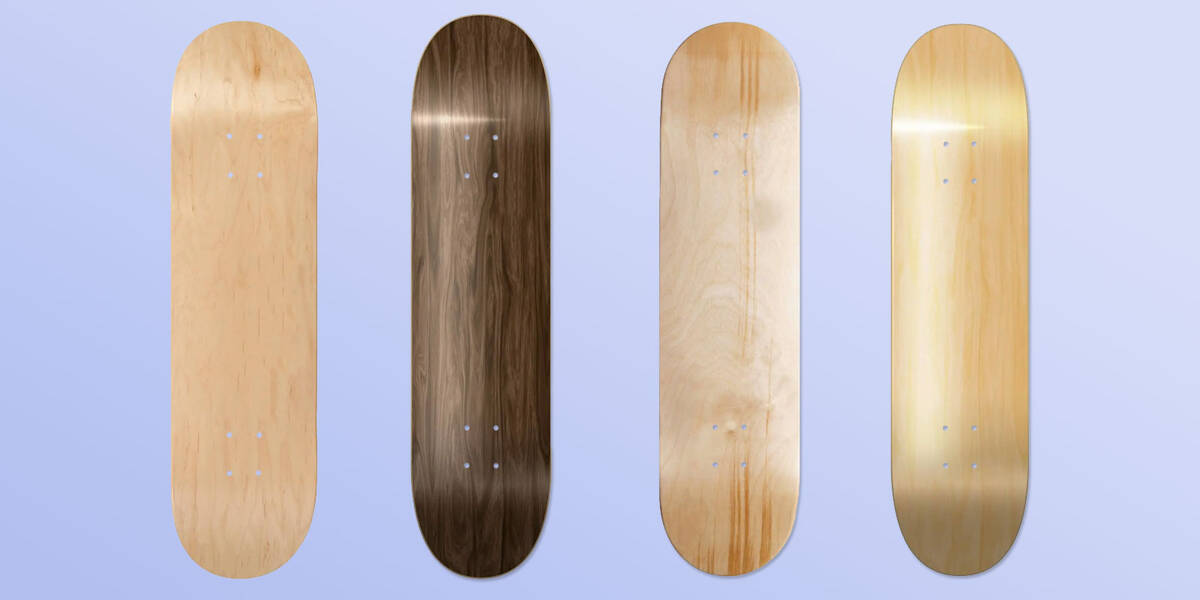Guide to Buying Skateboard Decks
Choosing the right skateboard deck is not rocket science, but it does require a bit of thought beyond finding the most appealing deck graphics. You may be wondering how to find the right size skateboard deck, or what skateboard deck shape works best for you. And what is the best wood for a skateboard deck?
It doesn’t matter if you are looking for beginner skateboard recommendations or if you are a more advanced skater looking for a new deck. In this buying guide, we will try to answer the questions that may pop up while you are looking to buy the perfect skateboard deck.
Overview
Skateboard Deck Sizes: Choosing the Right Size Skateboard Deck
Your shoe size gives a good indication of the best skateboard deck size for you. The larger your shoe size, the wider your deck should be.
Your style of skateboarding is also important to your choice of deck width. A wider deck is generally better suited for vert and bowl, while a narrower deck is better suited for street and flip tricks. Consider the following:
- Wider decks: More stable and easier to land tricks on, simply because the platform you are landing on with your feet is bigger. However, the extra width comes with extra weight, and this means that it will require more power to get the skateboard off the ground and to flip it around.
- Narrower decks: More agile, and easier to flip since the deck weighs less. But of course, being smaller, it is also more difficult to catch the board when you flip it, and therefore it is theoretically a bit more difficult to land your tricks.
Ultimately, the choice is up to your personal preferences, but we recommend looking at our skateboard size guide, so you get an idea of the optimal size skateboard deck relative to the size of your shoes.
MATCHING DECK WIDTH AND TRUCK WIDTH

When it comes to matching skateboard deck and trucks, the general advice is this: Make sure that the width of your skateboard deck matches the axle width of your skateboard trucks. Ideally, the axle width of your trucks should be the same as the width of your deck, and they should not differ by more than a quarter of an inch.
Of course, it is your setup, and you may have different preferences, but this is a general guideline that most skaters will want to stick to.
SKATEBOARD LENGTH
Skateboard deck length is not something that concerns every skater because the length of the deck is usually proportional to the width, meaning that wider decks are longer, and shorter decks are narrower. The average skateboard deck length lies somewhere between 29” and 32”.
The length of the deck is important because it determines the wheelbase and therefore how stable your setup feels. You may also want to consider the length of your legs: if you have short legs, a shorter deck is easier to control, and if you have long legs, a longer deck is easier to control.
If you are into those really long skateboards, feel free to check out these pages:
Skateboard Deck Shapes: Popsicles, Eggs & Hybrids

1. Popsicle shape 2. Old School Shape 3. Hybrid Shape
Today, skateboard decks are widely associated with the popsicle skateboard deck shape, but this specific shape is nothing more than a step in an evolutionary process. The development of new skateboard deck designs goes hand in hand with the creativity of skateboarders pushing the limits of what can be done on their boards.
POPSICLE SKATEBOARD DECKS
Popsicle skateboard decks have a kick-tail and a kick-nose, allowing skaters to pop tricks with either end of the deck. The virtually symmetrical shape of the popsicle shape opened up a range of opportunities to do fakie tricks, nollies, nose slides, riding switch etc. Popsicle skateboard decks are closely related to the growth of street skateboarding in the early ‘90s, where skaters would break new ground in the streets, innovating flip tricks, slides, and grinds.
SHAPED SKATEBOARD DECKS
Trends come and go, and of course the popsicle stick shape is just one of many types of skateboard decks. The so-called hybrid skateboard decks hybridize the popsicle stick shape with the shapes of old-school decks.
Some skaters favor egg-shaped skateboard decks, and these are often more than 9 inches wide. Rather than having parallel edges like a popsicle stick, they have an oval shape that is said to offer some of the agility of popsicle shaped skateboard decks while giving a large, stable platform for your feet.
There are many old-school decks on the market. You can take them to the bowl or cruise the streets - what you do with them is entirely up to you! Check out our cruiser skateboard decks to see some very nice retro deck shapes:
What is the Advantage of Skateboard Deck Concave?

Deck concave is another significant feature of modern skateboard decks that came with the rise of technical street skateboarding. The concave is the curvature of the skateboard from edge to edge. Many skaters feel that the concave makes it easier to flick the board when doing flip tricks and that it provides more leverage for tricks. It helps to keep the feet in place on the board, and the concave shape also stiffens the deck. Typically, the skateboard deck concave is divided into three classes; low, medium, and high:
- Low concave: Subtle curvature that provides a stable ride with a low center of gravity.
- Medium concave: Facilitates flip tricks and control. Medium concave is a safe choice.
- High concave: Drastic curvature that significantly affects the characteristics of the board. It is known to provide agility and to make it easier to flip the board.
The concave of the deck you end up choosing will influence your riding, so consider how it affects these aspects:
- Comfort and feel of the deck
- Leverage when doing tricks
- Stiffness and thereby the pop of the deck
What Kinds of Wood are Skateboard Decks Made of?

Maple is by far the most typical wood type for skateboard decks. This is due to its inherent characteristics like strength, impact resistance, low weight, and flexibility.
Skateboard decks are made of layers of wood that are molded and pressed together with either glue or epoxy between the layers. The majority of skateboard decks are 7-ply maple, which refers to the fact that the board is made of 7 plies, or 7 veneers, of maple. Maple wood is easy to shape and effectively keeps its shape after the molding process, making it an ideal wood type for skateboards.
There are different types of maple wood, and they all have different properties. For example, Canadian maple is known to be 15% harder than Chinese maple. The density of Canadian maple is attributed to the slower growth of trees in colder climates, resulting in denser growth rings compared to maple grown in warmer conditions.
If you are looking for a deck that can handle a lot of heavy use and has lots of pop and stiffness, always go for the hardest wood type. If you are a beginner, then the minor differences in hardness may not matter as much as the price difference – and you will be perfectly able to learn and be creative on a deck of lesser quality.
Final Skateboard Deck Recommendations and Further Reading
When buying a new skateboard deck, it is important that you have some griptape ready. See our large selection here:
Find more general info about the different parts of skateboards in this guide:
If you have any doubts about how to grip your new deck or anything else related to skateboard assembly, check out this guide:
Discover our completes here:
If you want to get a complete skateboard made up of your favorite parts, we have a very convenient solution for you
